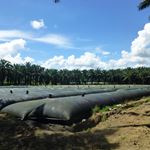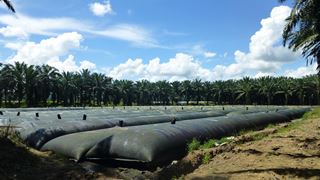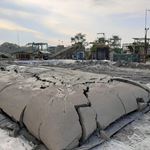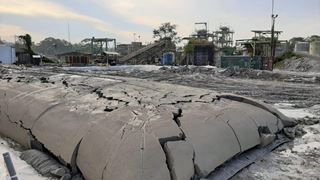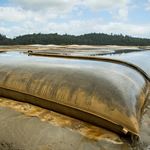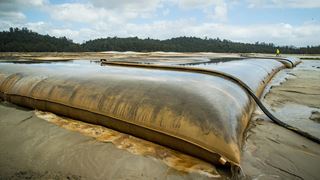Case story
Overcoming Work Space Constraints in Urban Municipal Wastewater Treatment Plants with TenCate Geotube® Dewatering Technology
Malaysia, Kuala Lumpur
The Challenge
The Pantai 2 Sewage Treatment Plant (STP) project located within an urban residential area in Kuala Lumpur, involved the upgrading of an old aerated sewage lagoon into a modern and enclosed underground sewage treatment facility. The shortage of space within the existing facility required the old sludge lagoons to be dewatered before construction of the new plant could begin.
The Solution
Several options of dewatering the sewage lagoons were evaluated taking cost, practicality, efficiency, space availability and the surrounding urban environment into consideration. Geotube® dewatering technology has the advantages of being able to handle very large sludge volumes, achieving very high solids capture rate and requiring low capital investment as compared to other alternatives. With the lack of workspace at the project site, TenCate Geotube® dewatering units could be custom-sized to fit into the available work space within the lagoon footprint and provide a secure odour-free containment of the dewatered solids until they are removed.
An earthfill bund was formed to segment out a small area within the aeration lagoons. The sludge within was then pumped into the adjacent aeration lagoons to dry out this area. This enabled the first Geotube® dewatering cell to be formed within the original layout of aeration lagoons. As dewatering works progressed, more dry areas became available for use as dewatering cells. This is an effective but simple work program that was carried out efficiently in phases.
Dewatering Operations
The solids concentration of the sludge in the ponds was approximately 10%. Dewatering tests were undertaken to check the Geotube® dewatering efficiency which indicated a final dewatered solids concentration of 30% within the tube units. This could be achieved with a tube dewatering capacity of 60% - 65% after about 6 filling cycles. Based on these results, it was determined that the total required length of 920 m of tubes with a circumference of 36.6 m was required. The lengths of individual tube units were then sized to fit within the cell spaces.
Construction of the initial cell bund included placement of geotextiles and drainage aggregates to facilitate the collection of discharged effluent water before deployment of the tubes into the first dry cell bed. This is followed by the dredging of sludge from the adjacent lagoon at a rate of 250 m3/h in a 10 hour daily operation work cycle. Prior to pumping into the tubes, the slurry was injected with cationic polymer at a dosage between 1 to 1.5 kg per metric tons of dried solids.
The Performance
Geotube® dewatering technology was successfully used for the cleanout of the aeration lagoon for the Pantai 2 Sewage Treatment Plant Project. The use of Geotube® dewatering technology enabled the sludge dewatering works to be carried out within a segmented area of the aeration lagoon, overcoming the difficulty of lack of work space at the site. After completion of the desluging works, the Geotube® dewatering units were cut up and the solids were taken to an approved landfill for disposal. Thereafter, ground improvement works began in preparation for construction of the new treatment plant.
Further information on this and other large-scale Geotube® dewatering projects can be obtained by contacting us at TenCate Geosynthetics Asia.
Geotube® Dewatering Technology for Cleanout of Aeration Lagoon at Pantai 2 Sewage Treatment Plant
Aerial view of aeration lagoon with construction of earth bund wall barrier
Cross section of Geotube® dewatering cell details
Earthfill bunding
Segmented cleanout of lagoon
Dredging
Dewatering cell and Geotube® units deployed
Polymer mixing tank
Filling of Geotube® units
Geotube® units fully deployed
Geotube® units cut and opened
Solids were removed and disposed to a landfill
Earth filling works



